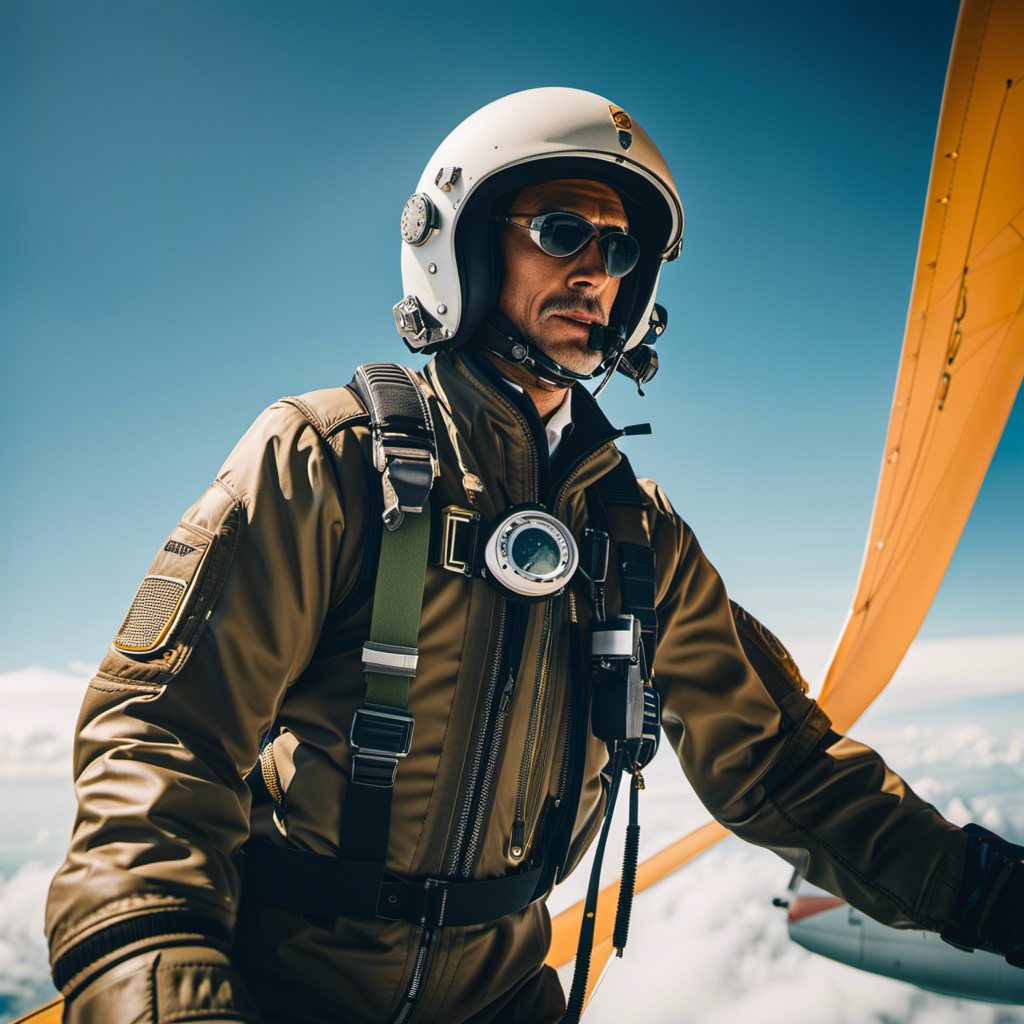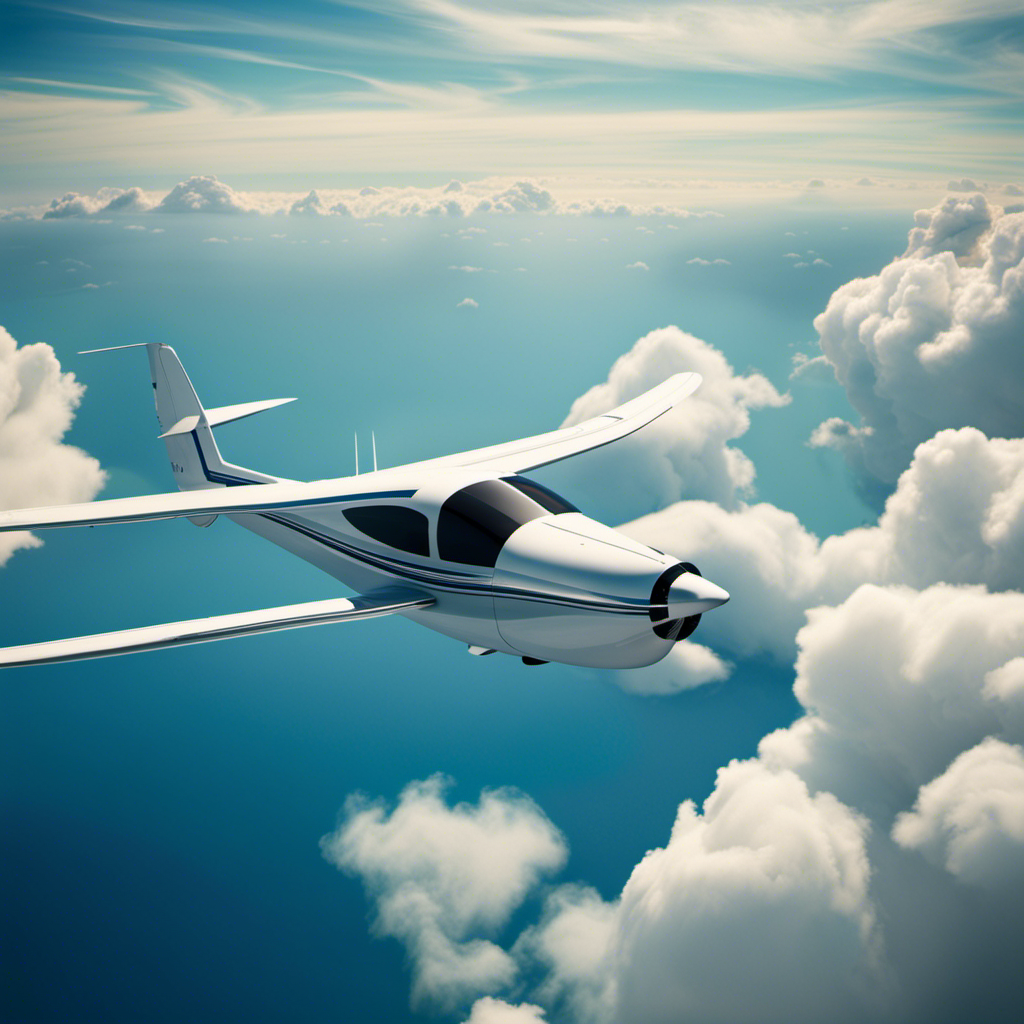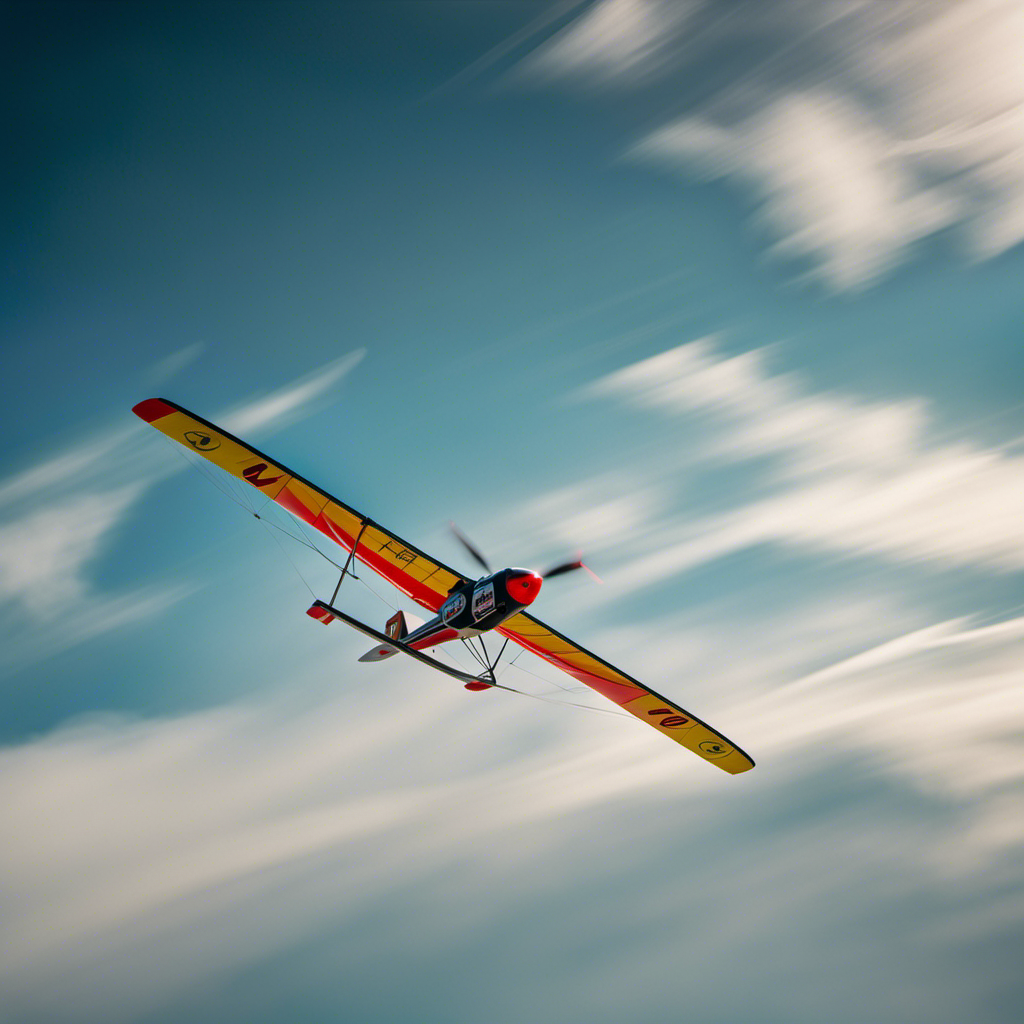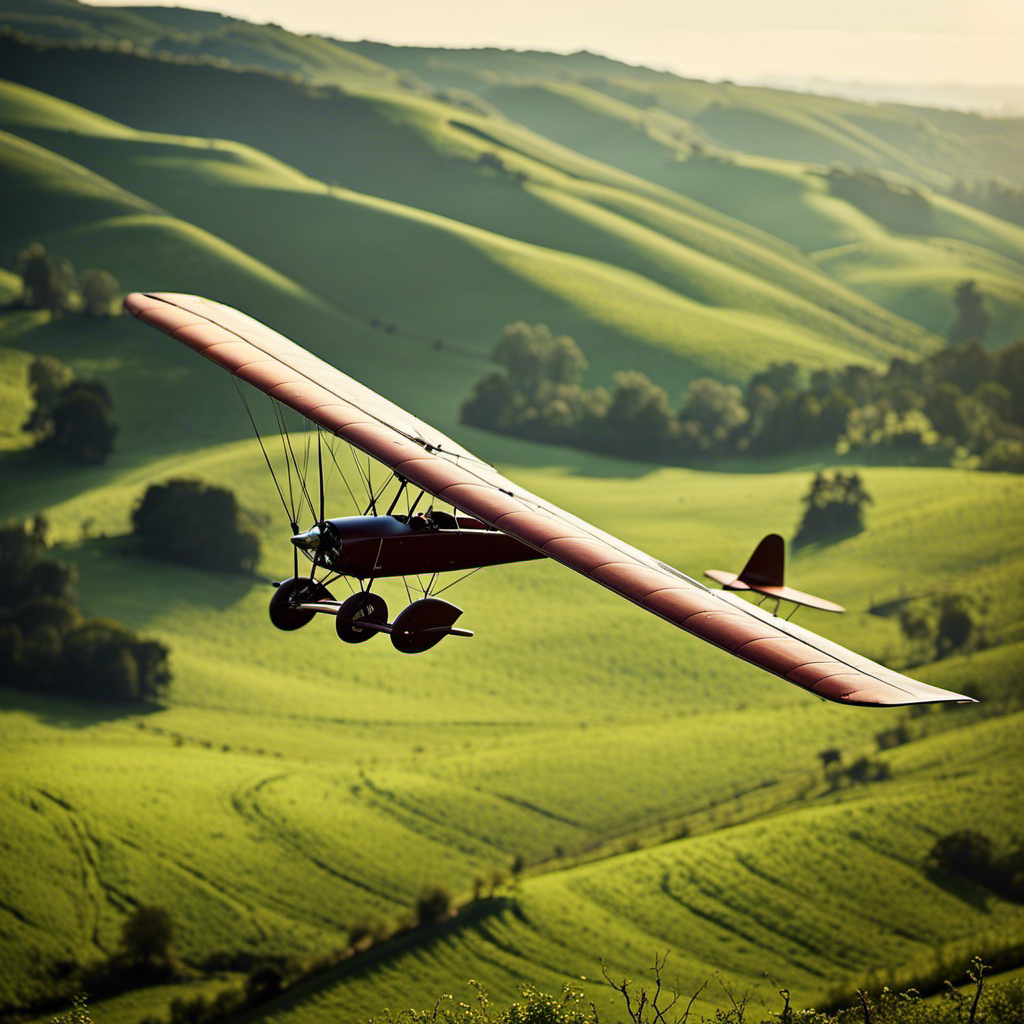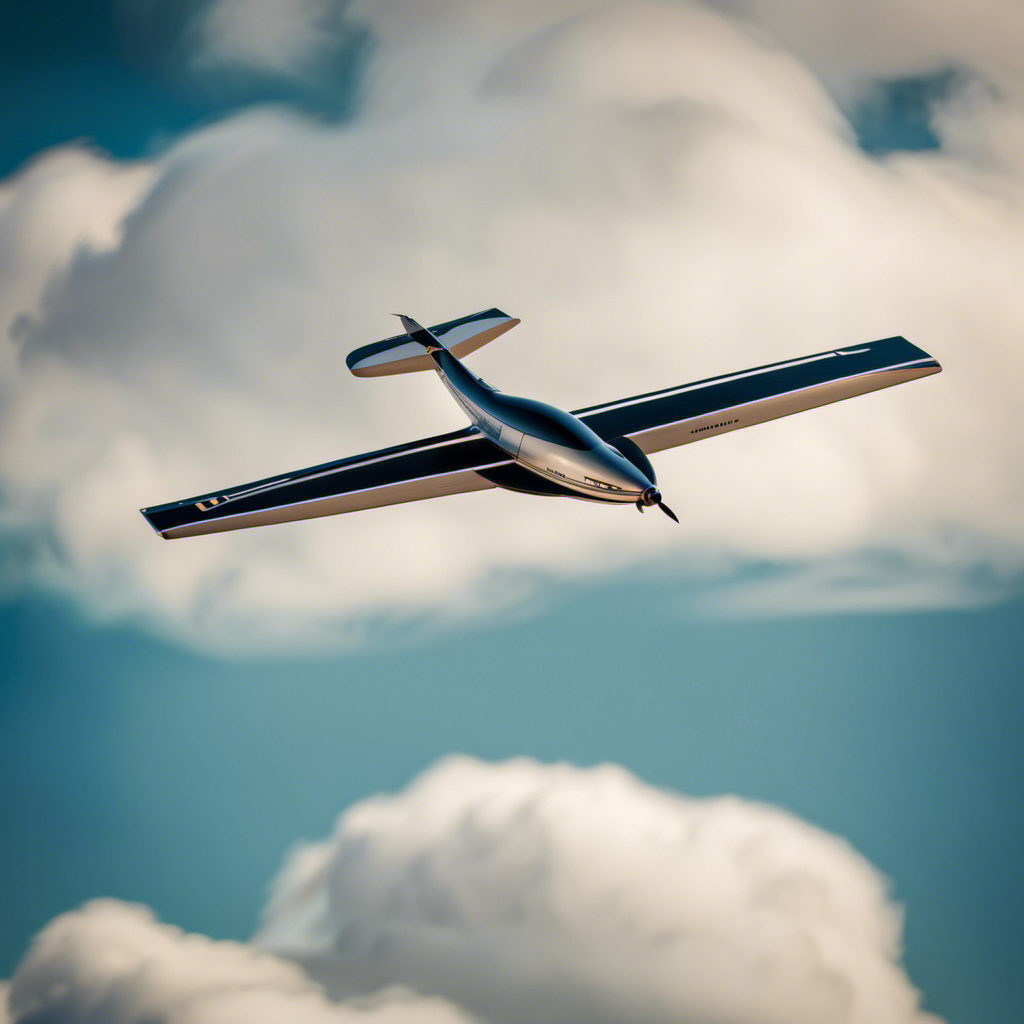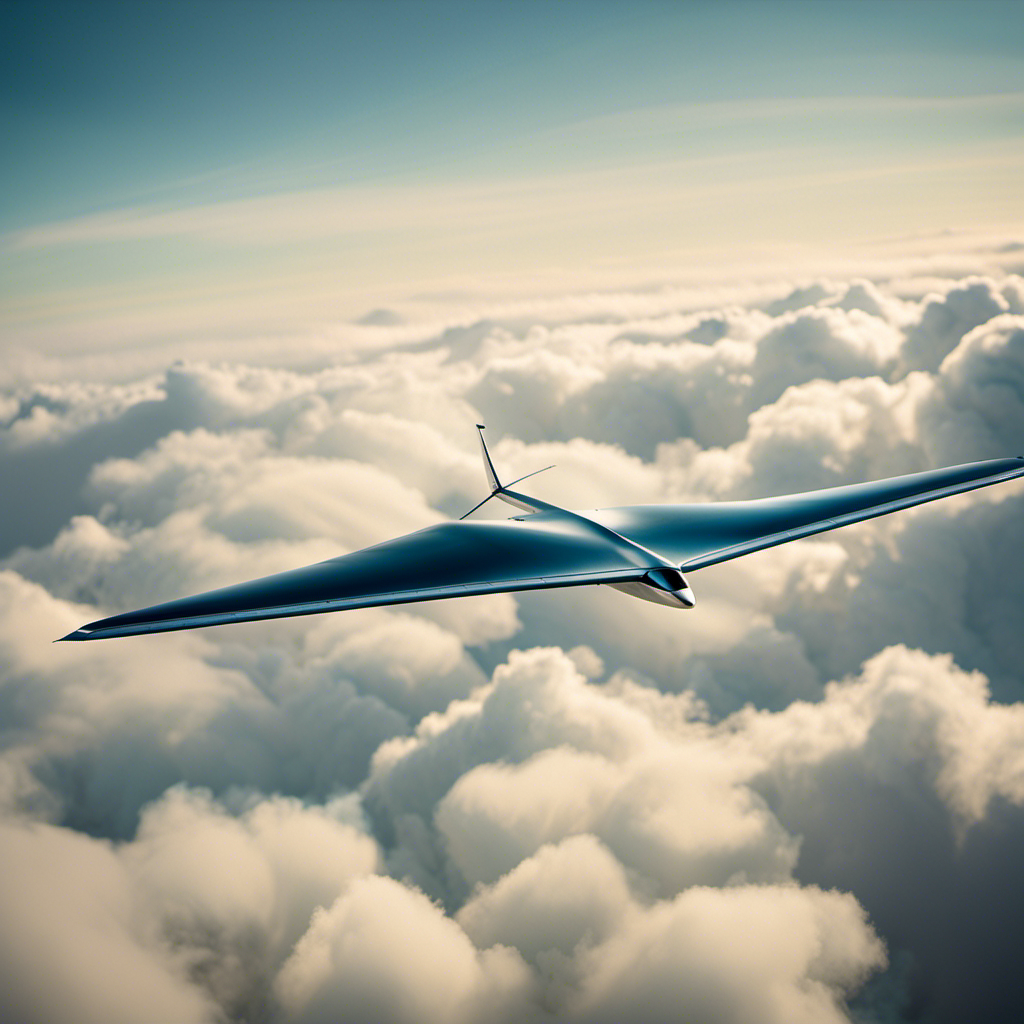As someone who pilots their own aircraft, I have always been captivated by the thrill of aviation. Lately, I have been yearning for a new type of adventure that will allow me to gracefully and peacefully soar through the skies.
That’s when I discovered glider flying. In this article, we’ll explore the fascinating world of gliders and answer the burning question: Can a private pilot fly a glider?
Get ready to embark on an adventure that will take your love for flying to new heights.
Key Takeaways
- Private pilots can fly gliders after obtaining the necessary training and certification.
- Glider flying requires transitioning from powered aircraft and mastering the skills of soaring.
- Safety considerations and tips are important for private pilots interested in glider flying.
- There are numerous benefits and opportunities in glider flying, such as cost-effectiveness and joining glider clubs.
The Difference Between Powered Aircraft and Gliders
You can’t fly a glider with an engine, unlike powered aircraft. Gliders are unique in that they rely solely on the forces of nature to stay airborne. This means that glider pilots need to develop a different set of skills and techniques compared to powered aircraft pilots.
Training programs for glider flying focus on teaching pilots how to effectively use updrafts and thermals to gain altitude and extend their flight time. These programs also cover essential flying techniques such as aerotowing, winch launching, and ridge soaring. By mastering these techniques, glider pilots can navigate the skies with precision and confidence.
Transitioning into the next section about training and certification requirements for glider flying, it is crucial to understand the foundation of flying a glider.
Training and Certification Requirements for Glider Flying
To become certified for glider flying, it’s important to complete the necessary training requirements.
The certification process for glider pilots involves a combination of ground school and flight training. Ground school covers topics such as aerodynamics, weather, navigation, and emergency procedures. This knowledge is essential for understanding the principles of glider flight and ensuring safety in the air.
Flight training includes both dual instruction with a certified flight instructor and solo flights to develop proficiency. During this training, pilots learn how to launch, control, and land gliders using the unique techniques specific to these aircraft.
In addition to the training requirements, aspiring glider pilots must pass a written exam and a practical flight test to obtain their glider pilot certificate.
Transitioning from powered aircraft to gliders requires adapting to the differences in handling, performance, and flight characteristics, which we will explore in the next section.
Transitioning from Powered Aircraft to Gliders
Transitioning from powered aircraft to gliders can be challenging due to the differences in handling, performance, and flight characteristics.
As a private pilot, I had to overcome these challenges when I decided to venture into glider flying. One of the biggest differences I noticed was the absence of an engine. Without the power to maintain altitude, glider pilots must rely on their understanding of atmospheric conditions and their ability to exploit rising air currents to stay aloft. This requires a different set of skills and a deeper understanding of aerodynamics.
Additionally, glider competitions bring a whole new level of complexity, with pilots having to navigate challenging tasks and make strategic decisions. However, with the right training and practice, transitioning to gliders can be a rewarding experience.
Understanding the basics of glider flight is essential and will be discussed in the next section.
Understanding the Basics of Glider Flight
Understanding how gliders stay aloft without an engine is crucial in learning the basics of glider flight. Gliders rely on the principle of lift to stay in the air. By utilizing the natural upward force generated by the movement of air over their wings, gliders can soar through the sky.
To maximize lift, pilots must master techniques such as finding thermals, which are columns of warm air that can provide a significant lift. Safety precautions are also essential in glider flight. Pilots must be aware of weather conditions, as certain weather patterns can be hazardous for gliding. Additionally, proper pre-flight inspections and maintenance ensure the glider is in optimal condition for flight.
Mastering the Skill of Soaring
Once you’ve honed your skills and become comfortable with the basics, soaring through the sky in a glider is an exhilarating experience. To truly master the skill of gliding, it is important to learn and practice advanced techniques. These techniques include:
-
Thermaling: This involves using rising columns of warm air to gain altitude and extend your flight time.
-
Ridge soaring: By flying along the edge of a ridge or mountain, you can harness the wind to stay aloft and cover long distances.
-
Cross-country flying: This advanced technique involves planning and executing flights over great distances, utilizing thermals and ridge lift to navigate and stay airborne.
By mastering these techniques, you can take your gliding abilities to new heights.
The joys and challenges of gliding await, where you will experience the freedom of soaring through the skies and the thrill of navigating through ever-changing air currents.
The Joys and Challenges of Gliding
Experiencing the freedom of soaring through the skies in a glider brings immense joy and a unique set of challenges. As a pilot, I have encountered the exhilaration of riding thermals and the thrill of ridge soaring.
Thermals, columns of rising warm air, pose both a challenge and an opportunity for glider pilots. Finding and utilizing these thermals effectively is crucial for gaining altitude and extending flight time. It requires a keen understanding of weather patterns and skillful maneuvering.
On the other hand, ridge soaring involves flying close to the windward side of a hill or mountain, utilizing the upward airflow created by the wind hitting the slope. It offers an incredible sensation of gliding effortlessly along the terrain. However, it also demands precise control and constant awareness of the changing wind conditions.
Transitioning to the next section, safety considerations in glider flying are of utmost importance to ensure a smooth and secure journey.
Safety Considerations in Glider Flying
After exploring the joys and challenges of gliding, it is essential to address the safety considerations in glider flying.
As a private pilot, I understand the importance of taking proper precautions to ensure a safe flight. Before taking off, it is crucial to thoroughly inspect the glider and ensure all equipment is in working order.
Additionally, understanding and adhering to weather conditions is vital. Gliders are sensitive to wind and thermal conditions, so it is crucial to check weather forecasts and consult with experienced glider pilots before flying. Paying attention to wind speed, direction, and any potential turbulence is crucial for a smooth and safe flight.
By prioritizing safety precautions and being aware of weather conditions, private pilots can enjoy the exhilarating experience of gliding.
Now, let’s move on to some helpful tips for private pilots interested in gliders.
Tips for Private Pilots Interested in Gliders
To maximize my enjoyment of gliding, I should consider these helpful tips. When it comes to training options, there are two main routes to consider: self-study or formal instruction. Self-study involves purchasing books and online resources to learn about glider flying. Formal instruction, on the other hand, involves enrolling in a glider flight school or hiring a certified flight instructor. Choosing the right glider is crucial as well. Factors to consider include the glider’s performance, weight, and the type of flying you want to do. It’s important to find a glider that suits your skill level and goals. By taking these tips into account, I can make informed decisions and have a safe and enjoyable gliding experience. Now, let’s explore the exciting world of glider clubs and communities.
| Training Options | Choosing the Right Glider |
|---|---|
| Self-study | Performance |
| Formal Instruction | Weight |
| Type of Flying |
Exploring Glider Clubs and Communities
Joining glider clubs and becoming part of the glider community can provide a wealth of opportunities for learning, networking, and sharing experiences with fellow enthusiasts. These clubs are a great way to immerse yourself in the world of gliding and connect with like-minded individuals who share your passion for flying.
One of the benefits of being part of a glider club is the chance to participate in glider competitions. These events not only test your skills as a pilot but also allow you to meet and compete against other glider pilots from around the world.
Additionally, being part of a glider club means having access to resources and support for glider maintenance. Club members often have extensive knowledge and experience in maintaining gliders, and they can provide valuable guidance and assistance when it comes to keeping your aircraft in top condition.
As we explore the cost of glider flying in the next section, it is important to consider the financial aspects of being part of a glider club.
The Cost of Glider Flying
Glider flying can be an expensive hobby, with costs including equipment, maintenance, and club fees. A thorough cost analysis is essential before embarking on this exhilarating adventure. Let’s break down the expenses in a table to get a clearer picture:
| Expense | Average Cost |
|---|---|
| Glider | $25,000-$100,000 |
| Trailer | $2,000-$10,000 |
| Annual Inspection | $500-$1,500 |
| Club Membership | $500-$1,000 per year |
| Insurance Coverage | $300-$800 per year |
As you can see, the initial investment for a glider can vary greatly depending on the model and condition. Maintenance costs, including the annual inspection, trailer expenses, and club membership fees, also need to be factored in. Additionally, insurance coverage is crucial for peace of mind and protection. It is important to note that insurance costs may vary depending on factors such as the pilot’s experience and the value of the glider. Now that we have examined the cost analysis and insurance coverage, let’s delve into the recreational aspect of glider flying.
Transitioning into the subsequent section, glider flying not only offers a thrilling experience but also serves as a wonderful recreational activity.
Glider Flying as a Recreational Activity
Transitioning into the subsequent section, flying gliders offers a thrilling and enjoyable way to spend leisure time.
Glider flying not only provides a unique perspective of the world from above, but it also requires proper maintenance and knowledge of flying techniques.
Glider maintenance involves regular checks of the aircraft’s structure, control surfaces, and instruments to ensure safe operation.
Additionally, understanding glider flying techniques is crucial for a smooth and controlled flight. These techniques include proper use of the controls, understanding wind patterns, and executing efficient maneuvers.
By practicing these skills and ensuring proper maintenance, glider pilots can enjoy the freedom of soaring through the skies.
Moving forward, the world of glider flying expands beyond recreation to become a competitive sport, where pilots demonstrate their skills and compete against each other in various events.
Glider Flying as a Competitive Sport
As I mentioned earlier, glider flying is not just a recreational activity; it is also a competitive sport. Competitive glider racing has gained popularity among private pilots, offering them a thrilling and challenging experience. Participating in glider races allows pilots to put their skills to the test and compete against other skilled aviators.
Here are three benefits of glider flying for private pilots in the context of competitive glider racing:
- Adrenaline Rush: The intense nature of glider racing provides a rush of adrenaline, making it an exhilarating experience for pilots who enjoy pushing their limits.
- Improved Skills: Competing in glider races hones a pilot’s flying skills, including navigation, decision-making, and precision flying, as they strive to outmaneuver their opponents.
- Community and Camaraderie: Engaging in glider racing offers pilots the opportunity to connect with fellow aviation enthusiasts, fostering a sense of camaraderie and building lasting friendships within the glider flying community.
Now, let’s delve into the unique experience of silent flight.
The Unique Experience of Silent Flight
Experiencing the tranquility of silent flight is a truly remarkable and immersive experience. As a pilot, being a part of the gliding community allows me to enjoy the serenity of soaring through the skies without the noise of an engine.
The silent flight experience is unlike any other, as I am able to fully appreciate the beauty and majesty of the world below. It is a feeling of freedom and peace that cannot be adequately described.
The gliding community is a tight-knit group of individuals who share a passion for this unique form of aviation. We come together to share our experiences, learn from one another, and support each other in our love for silent flight.
Transitioning to the subsequent section about glider flying and aerobatics, the exhilaration of performing aerobatic maneuvers in a glider takes the silent flight experience to new heights.
Glider Flying and Aerobatics
You’ll be amazed at the exhilarating maneuvers and adrenaline rush that come with performing aerobatics in a glider. Glider flying isn’t just about peaceful soaring; it can also be a thrilling adventure.
Aerobatic maneuvers in a glider involve executing precise and dynamic movements in the sky, such as loops, rolls, and spins. These maneuvers require skill, concentration, and an understanding of the glider’s capabilities.
Glider competitions often include aerobatic categories, where pilots showcase their abilities in front of judges. The precision and grace displayed during these competitions are truly awe-inspiring.
As a pilot, it’s a fantastic way to push your limits and experience the thrill of aerobatics in a unique and challenging environment.
Now, let’s explore the resources available for private pilots interested in gliding.
Resources for Private Pilots Interested in Gliding
There are many resources available to help individuals interested in gliding. Whether you’re a private pilot looking to expand your flying skills or someone completely new to aviation, there are training options that can cater to your needs.
Here are some key resources to consider:
-
Gliding clubs: Joining a local gliding club is a great way to immerse yourself in the gliding community. You’ll have access to experienced instructors, training programs, and a supportive network of fellow enthusiasts.
-
Flight schools: Many flight schools offer gliding training programs for private pilots. These programs typically include ground instruction, flight training, and the opportunity to earn a glider pilot license.
-
Online resources: There are numerous websites, forums, and online courses dedicated to gliding. These resources provide valuable information on glider operations, safety, and equipment needed.
Frequently Asked Questions
What are the safety considerations for glider flying?
Safety precautions for glider flying include thorough pre-flight inspections, proper use of safety equipment, and adherence to weight and balance limits. Training requirements for glider pilots include ground school, flight instruction, and a written and practical exam.
Are there any tips for private pilots interested in gliders?
When it comes to private pilots interested in gliders, it’s important to understand glider aerodynamics and flying techniques. Learning about weight shifts, thermals, and soaring methods will greatly enhance your glider flying experience.
How can private pilots explore glider clubs and communities?
To explore glider clubs and engage with the community, I recommend reaching out to local glider clubs, attending their events, and joining online forums or social media groups dedicated to glider flying.
What are the training and certification requirements for glider flying?
To fly a glider, I must complete specific training requirements and go through a certification process. This includes theoretical and practical instruction, solo flights, and passing a written and practical exam administered by the FAA or equivalent aviation authority.
What is the cost of glider flying?
The cost of glider flying varies depending on factors such as location, type of glider, and length of flight. Glider clubs offer affordable membership options and often host soaring competitions for pilots to participate in.
Conclusion
In conclusion, the world of glider flying is an enticing and thrilling one for private pilots. The challenge of mastering the skill of soaring, the competitive nature of glider flying as a sport, and the unique experience of silent flight all make it an incredible adventure.
Transitioning from powered aircraft to gliders may require additional training and certification, but with dedication and passion, private pilots can take to the skies in these graceful and exhilarating machines.
So why wait? Explore the world of gliding and discover the joy of flying without an engine.
Orion, better known as “Jetstream,” is the voice that brings the stories of the skies to life. His fascination with aviation began at a young age, sparked by his father’s tales of flying and adventure. Orion’s journey into the world of gliding was serendipitous, and from the moment he took his first glider flight, he knew he had found his calling.
